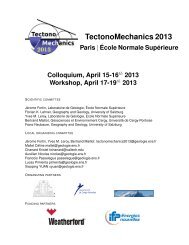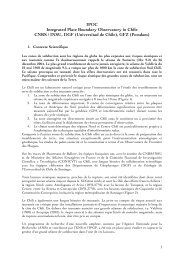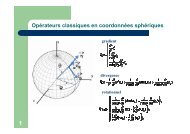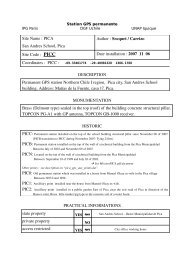PDF file - Laboratoire de Géologie de l'Ecole normale supérieure - Ens
PDF file - Laboratoire de Géologie de l'Ecole normale supérieure - Ens
PDF file - Laboratoire de Géologie de l'Ecole normale supérieure - Ens
Create successful ePaper yourself
Turn your PDF publications into a flip-book with our unique Google optimized e-Paper software.
SIMONS ET AL.: GPS MEASUREMENTS IN S.E. ASIA TO REFINE SUNDALAND MOTION X - 5<br />
the multi-day averaged (local) solutions, and hence the daily coordinate<br />
repeatabilities shown in Table 2, give a realistic indication of<br />
the internal accuracy of the network processed. In a final stage, the<br />
formal errors, which typically are un<strong>de</strong>restimated in the GIPSY PPP<br />
strategy, are scaled using the overall repeatability of each averaged<br />
solution. This results in realistic errors, which in turn, will result<br />
in more realistic formal errors in the site velocity estimation, and<br />
automatically weighs the contribution of each campaign/weekly averaged<br />
solution. Therefore it is not required to ’artificially’ scale up<br />
the formal errors as sometimes is done.<br />
The daily station coordinate repeatabilities, together with the<br />
number of final and removed station coordinate solutions, are given<br />
in Table 2 as the Root-Mean-Square (RMS) of the daily station coordinate<br />
residuals for each campaign and/or year of the permanent<br />
data processed. The daily repeatabilities are in general better than<br />
respectively 2 and 4 mm for the horizontal positions and around<br />
9 mm for the height. A clear improvement can be seen since 1997,<br />
mainly due to an improvement in the GPS orbits and the amount<br />
of GPS satellites available. The measurements of 1996 exhibit the<br />
highest residuals, and are probably caused by a poorer quality of the<br />
GPS orbits in the observation time window of this year.<br />
An overview of the daily coordinate repeatabilities for the IGS<br />
stations can also be seen in Table 2. These show similar values as<br />
for the S.E. Asia network, and also here the 1996 positions show<br />
higher daily offsets. The east component is sometimes a bit larger,<br />
because the ambiguity resolving works less well for the global IGS<br />
sites inclu<strong>de</strong>d (baselines > 2000 km to the nearest site). It is interesting<br />
to notice that (relatively) more outliers were removed between<br />
1999 and 2001, mainly for stations located in the equatorial region.<br />
All these sites used Rogue SNR-8000 receivers, which had problems<br />
with tracking GPS satellites during periods of increased solar<br />
activity (higher ionospheric <strong>de</strong>lays). All these receivers have been<br />
replaced in the past 4 years with upgra<strong>de</strong>d or new GPS receivers.<br />
3.2. Mapping solutions in ITRF-2000<br />
Each (weekly/campaign) multi-day averaged solution was projected<br />
onto ITRF-2000 coordinate sets, each containing the positions<br />
of the 31 IGS stations at the middle epoch of each<br />
analyzed week/campaign. The ITRF-2000 GPS SINEX <strong>file</strong><br />
(http://lareg.ensg.ign.fr) is propagated to each of these epochs, and<br />
contains the full covariance matrix for the IGS stations subset.<br />
In the mapping process, any multi-day averaged IGS coordinate<br />
solutions, i<strong>de</strong>ntified as (horizontal and/or vertical) clear outliers with<br />
respect to the propagated ITRF-2000 solution were downweighted.<br />
The coordinate residuals of the IGS sites for all epoch transformations<br />
are shown in Table 3.<br />
The coordinate residuals of all IGS stations are small and consistent,<br />
with RMS values of 2 to 3 mm for the horizontal and about<br />
8 mm for the vertical position. These numbers correspond with<br />
the repeatabilities for the IGS sites in the above section, and hence<br />
confirms (only stable and linearly moving stations were used) the internal<br />
accuracies. From the total of 31 inclu<strong>de</strong>d stations, 13-23 were<br />
used in the mapping of all weekly/campaign solutions from 1994<br />
to 2003. The ITRF positions of BAKO, NTUS, PIMO (all in S.E.<br />
Asia), MKEA, KARR, SHAO and KUNM (mapping quality check)<br />
were estimated along with the S.E. Asia network. Since DARW and<br />
XIAN are relatively new in IGS and ITRF-2000, these stations were<br />
also not consi<strong>de</strong>red in the mapping. Finally, a number of sites, in<br />
chronological or<strong>de</strong>r COCO, KOKB, TSKB, GUAM, GOLD, FAIR<br />
and KOSG were automatically rejected from the mapping between<br />
1999 and 2003. This was due to jumps in the time series, which<br />
all could be traced back to seismic events, antenna changes and/or<br />
changes in the site marker/antenna setup. This GPS analysis allowed<br />
the <strong>de</strong>tection of horizontal jumps larger than 2 mm and about<br />
10 mm in the height in the time series of the permanent sites.<br />
The results of Table 3 together with the daily coordinate repeatabilities<br />
of the S.E. Asia and IGS sites (Table 2), indicate that the<br />
global accuracy with respect to ITRF-2000 of each multi-day averaged<br />
solution is in the range of 2-4 and 4-6 mm for the horizontal<br />
position components, and around 9-15 mm for the height.<br />
3.3. Velocity estimates in ITRF-2000<br />
In this paper only steady state site velocities are given, and these<br />
can be easily estimated by computing a (linear) fit through all ITRF-<br />
2000 mapped weekly site coordinates, and checking the residuals at<br />
each point in the time series. Also the velocity differences between<br />
this solution and the ITRF-2000 will be verified, for both sites that<br />
were and were not used in the mapping process.<br />
A linear velocity mo<strong>de</strong>l was fitted through all the available ITRF-<br />
2000 mapped coordinates for each individual site making use the<br />
GIPSY software utilities. In this process, combined coordinate solutions<br />
in ITRF-2000 i<strong>de</strong>ntified as clear outliers with respect to the<br />
linear velocity trend are downweighted. Jumps in site position can<br />
also be estimated, but this is primarily useful for time series of continuously<br />
operated stations, unless a campaign site was measured<br />
many times, both before and after a jump in position.<br />
The coordinate residuals for all the S.E. Asia and IGS sites w.r.t.<br />
to their estimated velocity trend are given in Table 4 for each of the<br />
Table 5. Residuals IGS stations w.r.t. linear trend fitting. Conform<br />
Table 4 the RMS of the residuals from the linear trend<br />
fitting are shown, but this time for individual IGS stations that<br />
were not used in the mapping into the ITRF-2000<br />
IGS Weekly RMS Residuals (mm)<br />
Station Solutions North East Up<br />
BAKO / Indonesia 189 (- 5) 3.2 3.4 9.7<br />
NTUS / Singapore 145 (- 7) 2.9 3.6 9.2<br />
PIMO / Phillipines 122 (-16) 3.9 4.0 12.4<br />
KUNM / China 157 (- 1) 2.5 3.6 8.5<br />
XIAN / China 79 (- 0) 2.5 1.9 6.8<br />
DARW / Australia 156 (- 8) 2.2 3.3 8.6<br />
KARR / Australia 200 (- 1) 1.5 2.6 8.1<br />
MKEA / Hawaii 184 (- 5) 1.7 3.4 8.4<br />
latitu<strong>de</strong> (cm)<br />
longitu<strong>de</strong> (cm)<br />
vertical (cm)<br />
15<br />
10<br />
5<br />
0<br />
-5<br />
-10<br />
-15<br />
-20<br />
trend = -8.40 _+ 0.14 mm/yr<br />
1994 1995 1996 1997 1998 1999 2000 2001 2002 2003 2004<br />
15<br />
10<br />
5<br />
0<br />
-5<br />
-10<br />
-15<br />
-20<br />
trend = 31.90 _+ 0.19 mm/yr<br />
1994 1995 1996 1997 1998 1999 2000 2001 2002 2003 2004<br />
15<br />
10<br />
5<br />
0<br />
-5<br />
-10<br />
site KUAL<br />
-15<br />
-20<br />
trend = 1.20 _+ 0.67 mm/yr<br />
1994 1995 1996 1997 1998 1999<br />
year<br />
2000 2001 2002 2003 2004<br />
Figure 3. MASS site KUAL: Coordinate time series in ITRF-<br />
2000. This site in Malaysia was originally a GEODYSSEA site,<br />
and became a permanent station at the end of 1998. The figure<br />
shows a marked outlier in 1997, and a vertical only outlier<br />
in 2001. The errors on the velocity component are 1-values,<br />
which do not require any further scaling.






